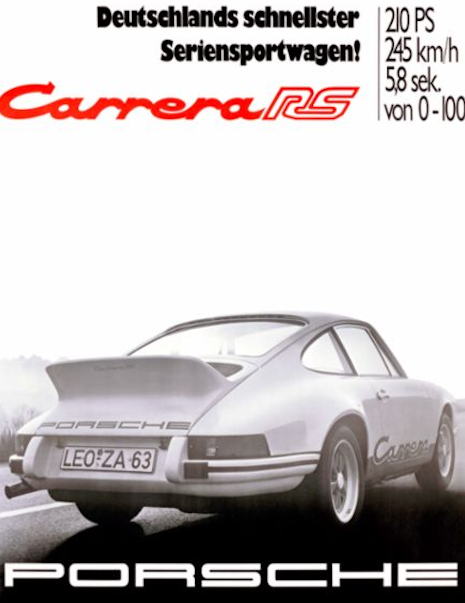 For 50 years, Porsche has been influencing the automotive industry through innovative design. Image credit: Porsche
For 50 years, Porsche has been influencing the automotive industry through innovative design. Image credit: Porsche
German automaker Porsche is spotlighting the impact of its 911 Carerra RS 2.7 on the automotive industry as the road-approved racecar celebrates its semicentennial year.
According to the automaker, the 911 Carrera RS 2.7 was the fastest German production vehicle of its time and is the first series-production model with front and rear spoilers. Beginning in September, the Porsche Museum will host a special exhibition dedicated to 50 years of the 911 Carrera RS 2.7.
“An anniversary is always exciting, and celebrating 50 years of the 911 Carrera 2.7 RS is no exception,” said Frank Wiesmann, manager of product communications at Porsche, Atlanta.
“The sportiest iteration of 911 and 718 models – most recently the 718 Cayman GT4 RS – wear the RS badge, symbolizing a track-bred vehicle due to a particularly high level of performance, driving pleasure and lightweight construction,” he said. “The 911 Carrera 2.7 RS was the first 911 model to wear this badge, setting the baseline for other road-legal Porsche 911 and 718 RS models to this day.”
History of the duck tail
In a short film celebrating its history, Porsche depicts the 911 Carrera RS 2.7 as a force to be reckoned with. In a dramatic narrative, the brand showcases the vehicle's speed and the roar of its engine, highlighting it as a car that was never supposed to be driven.
More than 50 years ago, Porsche initially planned to build 500 models to receive Group 4 Special GT certification, but then it also became road-approved. Consequently, when it was introduced at the Paris Motor Show in 1972, all 500 units had sold within a month.
Based on this immediate success, the brand produced a total of 1,580 models and tripled sales within the year. Once the 1,000th vehicle had been made, the 911 Carrera RS 2.7 had been homologated for Groups 3 and 4.
With the 911 Carrera RS 2.7, Porsche had successfully developed a sports car that could legally double as a racecar and grand tourer.
The 911 Carrera was initially built for racing
“The Porsche 911 Carrera RS 2.7 is known by many nicknames, but its significance remains unique,” Mr. Wiesmann said. “In 1972, Porsche thereby launched a trend for rear spoilers on series production cars.
“Even though the model variant was based on the 911, it ended up becoming a new base vehicle for racing and rallying that featured many technical innovations,” he said. “The most powerful model of the first generation of the 911 was the first 911 to be christened ‘Carrera’ – the crowning glory of the Porsche range.”
With this model, Porsche introduced the automotive industry to the idea of dual spoilers — one at the front and one at the rear — significantly altering the aerodynamics of everyday motorcars.
The company’s intention with this design was to minimize lift on the front and rear axles at high speeds to achieve more neutral handling. Elevating the rear spoiler, or “duck tail,” pushed the vehicle closer to the road and supplied the rear engine with more cooling air, ultimately raising the car’s top speed by 2.8 mph.
In August 1972, Porsche engineers Hermann Burst and Tilman Brodbeck and stylist Rolf Wiener filed a patent for the rear spoiler with the German Patent Office.
Heritage at its core
Examining its own history is a critical element of the Porsche brand ethos, as the company often looks to the past so that its customers can understand the brand it is today.
Earlier this year, the brand celebrated La Carrera Panamericana with a cinematic campaign using flashbacks to races in years past and testimonials about the emotional component of the event.
 An advertisement from 1972 for the 911 Carrera RS 2.7. Image credit: Porsche
An advertisement from 1972 for the 911 Carrera RS 2.7. Image credit: Porsche
La Carrera Panamericana began as a historic border-to-border event on the open roads of Mexico. The original iteration ran for five years, from 1950 to 1954, as many today still look back on the race in awe.
Porsche captured several drivers participating in this year's version of the race, with the same historical ground covered (see story).
In addition to digital media assets commemorating the anniversary of the 911 model and its overall heritage, Porsche released an exclusive 911 model honoring its history.
Limited to 750 vehicles, this version bears many details that serve as an ode to the designs of Ferdinand Alexander Porsche, creator of the 911, including the color of the vehicle.
The commemorative vehicle has a recognizable black exterior, seat panels in the classic checked pattern and the red second hand of the Porsche design subsecond clock from the Sport Chrono Package (see story).
“With every new model, it is important to maintain a connection to the past,” Mr. Wiesmann said. “There is a little piece of 356 and 911 in every new Porsche model, and every new model takes inspiration from the diverse history of our brand."
“Sometimes it is merely nuances, and yet these shape the character and overall impression of each new design.”